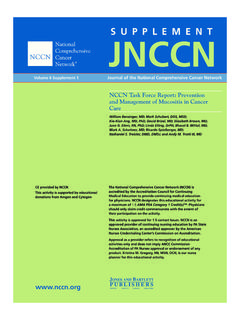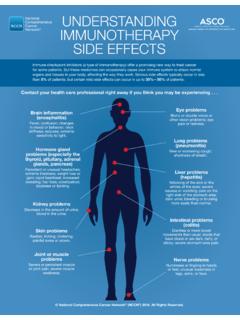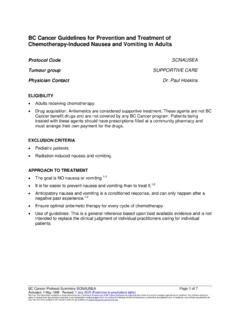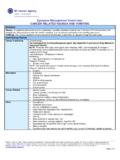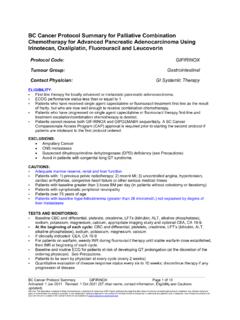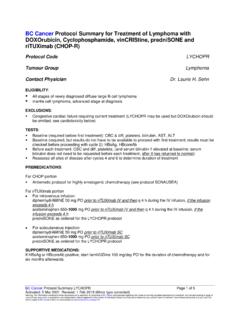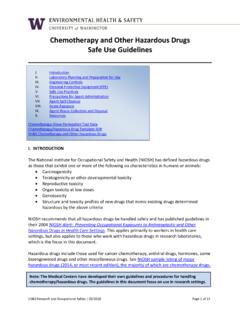Transcription of NCCN Guidelines for Patients Melanoma
1 Available online at Patients 2021 Presented with support from: Melanoma 1 NCCN Guidelines for Patients : Melanoma , 2021 MelanomaIt's easy to get lost in the cancer world 9 Step-by-step guides to the cancer care options likely to have the best results 9 Based on treatment Guidelines used by health care providers worldwide 9 Designed to help you discuss cancer treatment with your doctorsLet NCCN Guidelines for Patients be your guide About 2021 National Comprehensive Cancer Network, Inc. All rights reserved. NCCN Guidelines for Patients and illustrations herein may not be reproduced in any form for any purpose without the express written permission of NCCN. No one, including doctors or Patients , may use the NCCN Guidelines for Patients for any commercial purpose and may not claim, represent, or imply that the NCCN Guidelines for Patients that have been modified in any manner are derived from, based on, related to, or arise out of the NCCN Guidelines for Patients .
2 The NCCN Guidelines are a work in progress that may be redefined as often as new significant data become available. NCCN makes no warranties of any kind whatsoever regarding its content, use, or application and disclaims any responsibility for its application or use in any Foundation seeks to support the millions of Patients and their families affected by a cancer diagnosis by funding and distributing NCCN Guidelines for Patients . NCCN Foundation is also committed to advancing cancer treatment by funding the nation s promising doctors at the center of innovation in cancer research. For more details and the full library of patient and caregiver resources, visit National Comprehensive Cancer Network (NCCN) / NCCN Foundation 3025 Chemical Road, Suite 100 Plymouth Meeting, PA 19462 Guidelines for Patients are developed by the National Comprehensive Cancer Network (NCCN )National Comprehensive Cancer Network NCCN 9 An alliance of leading cancer centers across the United States devoted to patient care, research, and educationCancer centers that are part of NCCN.
3 Guidelines for Patients9 Present information from the NCCN Guidelines in an easy-to-learn format9 For people with cancer and those who support them 9 Explain the cancer care options likely to have the best resultsFree online at Clinical Practice Guidelines in Oncology (NCCN Guidelines )9 Developed by doctors from NCCN cancer centers using the latest research and years of experience9 For providers of cancer care all over the world 9 Expert recommendations for cancer screening, diagnosis, and treatmentFree online at and supported by funding from NCCN Foundation AboutThese NCCN Guidelines for Patients are based on the NCCN Guidelines for Melanoma : Cutaneous, Version February 19, Guidelines for Patients : Melanoma , 2021 SupportersEndorsed byAIM at MelanomaEvery week more than 3700 people in the United States are diagnosed with Melanoma , the deadliest form of skin cancer.
4 For all of these people and their families, information is critical for understanding and decision-making. AIM at Melanoma is pleased to endorse these NCCN Guidelines for Patients , an important tool for those touched by Melanoma to help educate them on Melanoma staging, tests, and treatment options. Research Alliance (MRA)The Melanoma Research Alliance endorses the NCCN Guidelines for Patients with Melanoma . The updated 2021 NCCN Guidelines are a valuable resource to assist Patients and caregivers in understanding the newest treatment approaches available and highlight the tangible progress that has been made over the past decade against this deadly disease. Research FoundationThe Melanoma Research Foundation is very pleased to endorse the NCCN Guidelines for Patients , which provide people who are living with cancer the same information that for years has informed doctors about the current best practices in care.
5 We believe that informed and empowered Patients live longer, better lives and this information is critical in a time when the treatment landscape is changing so Your Skin Foundation Save Your Skin Foundation (SYSF) is a Canadian patient-led not-for-profit group dedicated to the fight against non- Melanoma skin cancers, Melanoma and ocular Melanoma . By using and sharing the valuable and thorough NCCN Guidelines , SYSF is confident in their provision of solid patient support with accurate and current information on these cancers and related topics such as skin cancer treatment with immunotherapy. generous support fromStephen MagroTo make a gift or learn more, please visit or e-mail Guidelines for Patients : Melanoma , 20215 NCCN Guidelines for Patients : Melanoma , 2021 MelanomaContents6 Melanoma basics15 Testing25 Staging melanoma29 Treatment37 Early stage and stage 240 Stage 347 Recurrence52 Stage 4 metastatic disease57 Making treatment decisions66 Words to know68 NCCN Contributors69 NCCN Cancer Centers70 Index6 NCCN Guidelines for Patients : Melanoma , 202161 Melanoma basics7 Skin basics7 Melanin8 Melanoma10 Risk factors 13 Prevention13 Early detection14 Review7 NCCN Guidelines for Patients : Melanoma , 20211 Melanoma basics Skin basics1 Melanoma basics Skin basics | MelaninMelanoma begins in cells known as melanocytes.
6 Exposure to ultraviolet (UV) light causes deoxyribonucleic acid (DNA) changes that increase your risk of developing basicsYour skin is the largest organ of the body. It covers about 20 square feet. Skin protects you from invaders (such as microbes), helps control body temperature, and allows the sensations of touch, heat, and has 3 layers: Epidermis the outermost layer of skin, provides a waterproof barrier and creates skin color (melanin). Dermis contains tough connective tissue, hair follicles, and sweat glands. Hypodermis the deeper subcutaneous tissue made of fat and connective is the pigment (chemical) in skin that gives it color. Melanin is produced in cells called melanocytes. Melanocytes are found in the epidermis (top layer of skin). Melanin is responsible for the color of our hair, skin, and eyes. In addition to providing color, melanin also protects our skin from harmful ultraviolet (UV) levels and types are typically determined by genetics (genes passed down from your parents).
7 Other factors that affect melanin creation include: UV light exposure (UVB increases melanocytes) Hormones Age Skin pigment disordersMelanoma in the skinRegularly look for any new, changing, or unusual spots on both exposed and non-exposed Guidelines for Patients : Melanoma , 20211 Melanoma basics MelanomaMelanomaMelanoma is one of the most serious types of skin cancer because it has the highest rate of metastasis (spread to other sites of the body). It develops from pigment cells called melanocytes (cells that produce melanin). Exposure to ultraviolet (UV) light, such as sunlight or tanning beds, may increase your risk for developing Melanoma . It is important to understand the warning signs of skin cancer. Finding it and treating it early will help to produce more positive outcomes. Regularly look for any new, changing, or unusual spots on both exposed and non-exposed skin.
8 Melanoma is most commonly found on legs for women, and on the torso for occurs when something goes wrong in your melanocytes. When skin cells are damaged, new cells may grow out of control and can form a mass of cancerous cells. It is unclear how damage to cells leads to Melanoma . It is likely related to genetic and environmental factors. The clearest link is between exposure to UV radiation from the sun or tanning is important to note, however, that UV light does not cause all melanomas, especially in areas of your body that are not exposed to sunlight. Melanoma , skin cancerMelanoma has an irregular shape and different Guidelines for Patients : Melanoma , 20211 Melanoma basics MelanomaSigns and symptomsMelanoma can be found anywhere on your body. It often develops in areas of most sun exposure such as back, legs, arms, and face.
9 Sometimes, Melanoma can be found in areas with little to no sun exposure such as the soles of your feet, palms of hands, and underneath fingernails. People with darker skin are more likely to develop Melanoma in areas of less sun exposure. Be on the lookout for the following: A change in an existing mole (size, shape, or color) A new spot on the skin Ugly duckling sign (a spot that looks different from all other spots on your skin)If you have any of these signs, have your skin checked by a health care guide for signs of Melanoma is the ABCDE rule: Asymmetry One half does not match the other. Border The edges are irregular and are difficult to define. Color The color is not the same throughout (may be brown, black, or sometimes patches of pink, red, white, or blue). Diameter The spot is larger than 6 millimeters across (about the size of a pencil eraser).
10 Evolving The mole changes its size, shape, or 1 Melanoma risk factorsPredisposed characteristicsEnvironmental factorsFamily historySexAge10 NCCN Guidelines for Patients : Melanoma , 20211 Melanoma basics Risk factors Risk factors The exact cause of Melanoma is unknown; however, there are many risk factors. A risk factor is anything that increases your chance of getting a disease. Some risk factors are passed down through genes (parent to child), while others are associated with activities that people do. Having one or more risk factors does not mean you will get Melanoma . Some key risk factors for Melanoma are listed in Guide characteristicsAlthough uncommon, certain genetic changes, or mutations, can increase a person s chances of developing cancer. These changes, known as hereditary cancer syndromes, can be passed down from parent to child.



